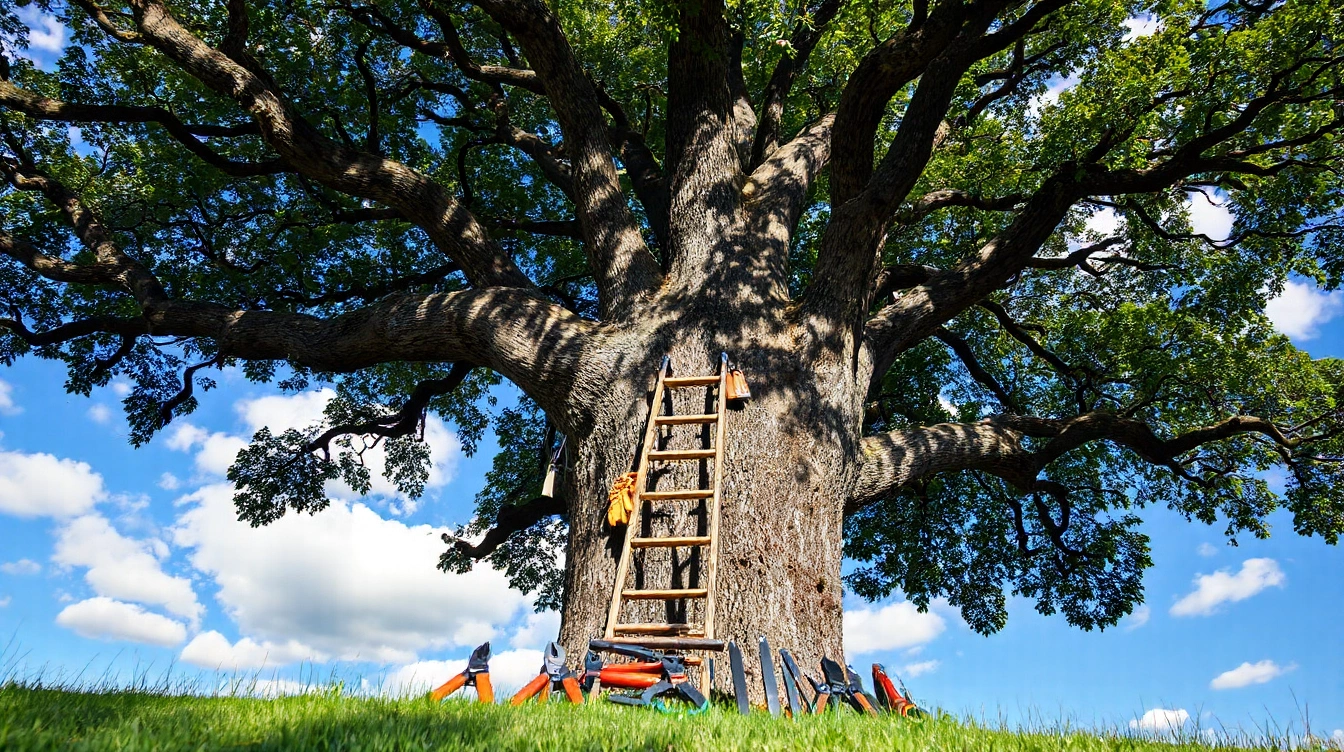Essential qualifications for tree surgeons: a comprehensive guide

Tree surgery demands more than passion for trees — it requires a blend of formal education, certified skills, and rigorous safety training. Understanding the qualifications essential for this profession ensures both personal safety and effective tree care, while opening doors to career advancement. This guide clarifies the standards, certifications, and practical experience that define competent tree surgeons, offering a clear pathway to mastering the craft and meeting industry expectations.
Overview of Essential Qualifications for Tree Surgeons
Becoming a skilled tree surgeon requires meeting specific tree surgeon qualifications that ensure expertise, safety, and professionalism. Understanding the arborist requirements is crucial for anyone pursuing this career, as these qualifications form the foundation for safe and effective tree care.
Topic to read : How Does Digital Storytelling Foster Engagement in Online Education?
The primary step in how to become a tree surgeon involves acquiring the right credentials. Typically, this includes completing recognised training programs that cover practical skills such as tree climbing, pruning, and the safe use of chainsaws, alongside theoretical knowledge about tree biology and health. Without these qualifications, tree surgeons cannot guarantee the quality of their work or adhere to safety regulations, which are vital for protecting both workers and clients.
Credible certifications and licenses often serve as proof of expertise and compliance with industry standards. These credentials are not only a mark of professionalism but also a key to better job opportunities and career growth within arboriculture. Most employers prefer candidates who have completed accredited courses aligned with national standards, ensuring they meet the comprehensive arborist requirements expected in the field.
This might interest you : Mastering the essentials: tree surgeon qualifications explained
Choosing the right tree surgeon qualifications benefits both the individual and the environment by promoting safe tree maintenance practices that preserve tree health and public safety. For those interested, exploring detailed training options such as Tree surgeon qualification courses can provide a structured pathway to entering this specialized profession.
Required Education and Foundational Training
Building a solid base in tree care
Aspiring professionals in tree surgery must prioritize obtaining comprehensive tree surgeon education that covers essential tree biology, safety protocols, and practical skills. The minimum education requirements typically include a high school diploma with a focus on relevant subjects such as biology, environmental science, and general horticulture. These subjects provide a crucial understanding of plant life cycles, anatomy, and ecosystems, which underpin effective tree care.
Enrolling in accredited arboriculture courses is highly recommended to develop expertise in tree maintenance and management. These programs, offered by vocational schools and colleges, often combine theoretical lessons with hands-on forestry training. Courses might cover topics like pest identification, pruning techniques, tree risk assessments, and the use of climbing equipment. Such specialized knowledge is vital for performing tree surgery safely and efficiently.
Foundational forestry training is equally important, as it equips learners with broader environmental awareness. This training highlights sustainable practices and ecosystem management, enabling tree surgeons to make informed decisions that protect both individual trees and their surrounding habitats. Overall, integrating biology instruction, practical arboricultural skills, and forestry principles ensures that trainees are well-prepared for the demands of the profession.
Individuals interested in advancing their careers can explore further through Tree surgeon qualifcation courses, which offer recognized certifications and in-depth skill development. These courses validate expertise, enhance employability, and often include safety certifications mandated by industry standards.
Certification and Licensing Requirements
When considering qualifications for tree surgeons, understanding the necessary certification and licensing is crucial. These credentials ensure professionals meet safety standards and possess the knowledge required for effective tree care.
Recognised certifications such as the NPTC (National Proficiency Tests Council) and the ISA Certified Arborist are among the most reputable in the industry. The NPTC focuses on practical skills and safety, while the ISA certification is internationally acknowledged, emphasizing comprehensive arboricultural knowledge.
Licensing requirements for tree surgeons vary significantly depending on the region or country. Some areas mandate specific licenses beyond certification, reflecting differing local regulations and safety standards. For example, the United Kingdom may require compliance with local council licensing, whereas in the United States, state or municipal licensing can affect tree surgeon practice legality.
The process for obtaining these credentials typically involves a combination of formal training, exams, and documented practical experience. Maintaining certification often requires continued professional development or periodic renewal exams to keep skills current and aligned with evolving industry standards.
Aspiring professionals can explore Tree surgeon qualification courses to assist in navigating these requirements effectively and securing the necessary arborist certification. Such courses provide structured pathways to meet licensing criteria and enhance technical expertise in this specialised field.
Comprehensive Safety Training and Compliance
Safety in tree surgery hinges on specialized health and safety training tailored for arboriculture professionals. Core safety courses covering chainsaw use, personal protective equipment (PPE), first aid, and working at height are essential to prevent accidents and ensure safe operations. For example, chainsaw safety training focuses on correct handling, maintenance, and emergency procedures, while PPE instruction emphasizes selection and proper use to reduce injury risks.
Understanding legal compliance in tree surgery involves familiarizing oneself with current health and safety regulations specific to tree work. Compliance is not just a formality; it is a vital aspect that governs day-to-day operations, minimizing liability and protecting both workers and clients. Employers and contractors must actively manage risks by implementing industry standards and following statutory guidelines.
Risk management in tree surgery integrates these training elements with environmental assessments to foresee potential hazards. Legal compliance tree work requires documenting safety measures, conducting regular site inspections, and maintaining up-to-date qualifications. Professionals seeking to solidify their expertise can consider enrolling in Tree surgeon qualification courses for accredited training that ensures comprehensive knowledge and compliance readiness.
Essential Technical Skills and Practical Experience
In the field of arboriculture, tree surgeon skills are fundamental for ensuring safety and effectiveness in all tree care operations. Core abilities include proficient climbing techniques, precise pruning methods, and accurate disease diagnosis, all of which require a deep understanding of tree biology and mechanics. Mastery of these skills allows tree surgeons to manage trees without causing harm, promoting longevity and health.
Supervised practical experience is indispensable. Engaging in hands-on training under the guidance of experienced professionals helps refine technical skills while reinforcing safety standards. Apprenticeships offer a structured environment where novices can learn essential procedures such as rigging, chainsaw operation, and the identification of various tree diseases and hazards.
Evaluating skill proficiency involves regular assessments, often through practical demonstrations and formal evaluations. Continuous development through refresher courses, workshops, and exposure to new techniques ensures that tree surgeons stay current with industry best practices. For those interested in advancing their qualifications, exploring Tree surgeon qualification courses can facilitate the acquisition of both theoretical knowledge and practical competence necessary for career growth.
Professional Memberships and Continuing Education
Belonging to arboricultural associations such as the Arboricultural Association or the International Society of Arboriculture (ISA) plays a pivotal role in a tree surgeon's career. These memberships provide access to a community of professionals, which fosters valuable networking opportunities and supports career progression. Professionals who engage actively in these organisations benefit from shared expertise, industry updates, and enhanced credibility.
One important question often asked is: What are the benefits of joining arboricultural associations? The answer is clear: members receive exclusive access to specialized resources, technical guidance, and invitations to conferences or events that promote professional development for tree surgeons. This involvement also encourages collaboration, which can lead to new career paths or business opportunities.
Continued education is another cornerstone for growth in this field. Ongoing workshops, training courses, and certification renewals ensure that a practicing arborist stays current with the latest techniques and safety standards. This commitment to learning not only strengthens skills but also increases job marketability. Tree surgeons who invest in their education demonstrate a dedication that clients and employers recognize and value.
For those looking to deepen their expertise or keep certifications active, enrolling in relevant courses is vital. Tree surgeon qualification courses are designed to meet the evolving demands of the profession and often include practical assessments alongside theory. This continual learning cycle is essential for maintaining competence and advancing within the arboriculture industry.
Regional Variations and Pathways into the Profession
Understanding tree surgeon regional requirements is essential for anyone pursuing a career in arboriculture. In the UK, becoming a tree surgeon typically involves achieving recognized qualifications such as the Level 2 and Level 3 Certificates in Arboriculture. These certifications focus on practical skills and safety knowledge tailored to the UK’s regulatory environment. Conversely, in the US, aspiring tree surgeons might pursue certifications from organizations like the International Society of Arboriculture (ISA), which emphasizes industry standards and safety practices specific to American regulations.
There are multiple career pathways in arboriculture beyond traditional academic routes. Many individuals enter this profession through apprenticeships, which combine hands-on experience with classroom learning. Apprenticeships offer a valuable alternative to purely vocational or academic pathways, providing real-world skills directly on the job. These programs often connect trainees with experienced tree surgeons, allowing them to learn essential techniques such as pruning, felling, and equipment handling under supervision.
Resources for guidance in career planning are numerous. Professional bodies and training providers often offer detailed advice tailored to regional requirements. For those exploring qualifications, Tree surgeon qualification courses provide structured curricula that address industry standards while offering flexibility for different learning styles and backgrounds. Whether you are considering academic study, vocational training, or apprenticeships, it’s important to evaluate your goals and regional standards carefully to choose the most effective path.
In summary, the route to becoming a qualified tree surgeon varies by location but consistently values practical experience coupled with recognized certifications. By exploring local requirements and available pathways, you can tailor your career journey in arboriculture for lasting success.
Resources and Further Information
Explore essential tree surgeon resources and arboriculture reference materials to build your knowledge and advance your career in tree surgery.
To deepen your understanding and stay up-to-date with industry standards, it’s important to consult official guidelines published by recognised forestry and arboriculture bodies. These documents offer detailed instructions on safety practices, pruning techniques, and environmental considerations specific to tree surgery. Using these resources ensures that your work meets professional standards.
For those seeking to enhance their qualifications or start a career, connecting with training providers and associations is crucial. These organisations not only offer structured courses but also provide invaluable career advice for tree surgery professionals. They guide you through the available tree surgeon qualification courses, which cover everything from practical skills to health and safety protocols.
When it comes to verifying certifications or understanding current qualification requirements, check with reputable external sources. Making use of reliable links for certification and qualification checks helps confirm the validity of qualifications and keeps you informed about changes in the profession. For further information, consider exploring specialized resources like Tree surgeon qualification courses, which provide detailed descriptions of necessary skills and accreditation pathways.
Staying informed with accurate and current arboriculture reference materials will significantly benefit both novices and experienced tree surgeons by supporting continuous professional development and ensuring best practices are followed consistently.
